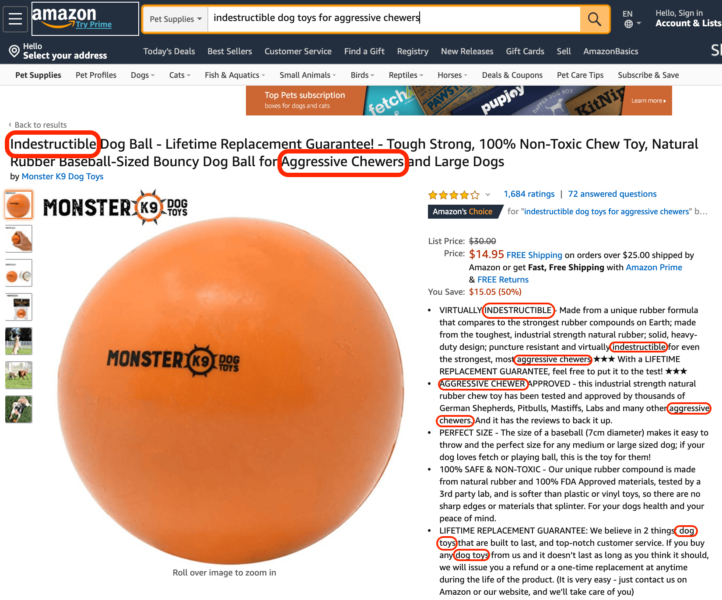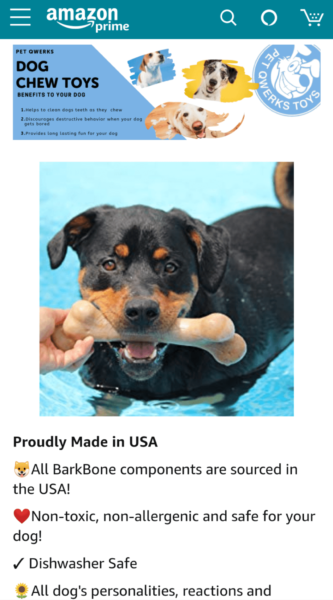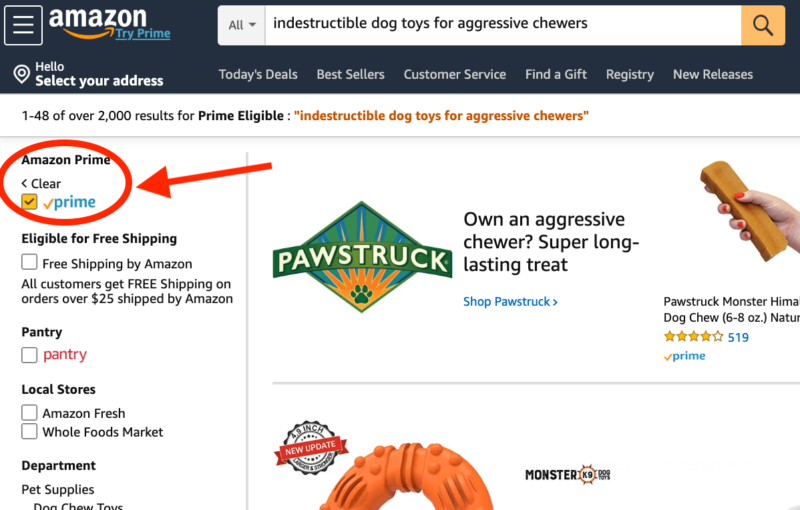Amazon’s A9 product ranking algorithm: Your guide to Amazon SEO for maximum visibility
Here’s what you need to know about the factors that affect your product’s organic visibility on Amazon.
Amazon is now the primary destination for product search, numerous studies and surveys have shown. And where there’s demand, there’s competition. There are now more brands competing to appear at the top of those Amazon searches than ever. That’s why understanding how Amazon’s A9 search algorithm works is critical to your success on the platform.
A9 is the system responsible for ranking product results on Amazon, and although it shares some similarities to traditional search engine algorithms like Google’s, there are a number of differentiators that will affect your listing’s visibility.
Optimizing for purchase intent
Users turn to Amazon when they are looking to buy. That makes A9’s job relatively straightforward: surface the products people are looking for. Unlike a traditional search engine, the A9 system doesn’t have to consider whether someone searching for “Stephen King” wants to learn more about the author or buy his books, for example. All searches are commercial.
To put it bluntly, the goal is to show results that are going to increase sales and margin for Amazon.
To do that, the A9 algorithm considers “factors such as degree of text match, price, availability, selection, and sales history.”
Related: The Periodic Table of Digital Commerce Marketing
Setting up your products for visibility and sales
Optimizing products for search on Amazon begins before your listing goes live. These are the optimization elements you have control over before a single unit is even sold.
Product detail page copy. “Amazon matches [keyword searches] against the information (title, description, and so on) that you provide for a product,” Amazon Seller Central’s page on optimizing listings explains. In Sellers should include relevant keywords within their product listing title, product description, key product features bullet points and the backend search terms (the keywords hidden from customers that sellers can add to a product’s catalog data).

“The number one thing that I would recommend for keyword research is harvesting your advertising,” said Nancy-lee McLaughlin, director of marketplace search for digital marketing agency Tinuiti. “So, looking at keywords that you have historically converted on and incorporating that into your product description and titles, [etc]. That would really be the number one piece because you’re then driving relevancy relative to the keywords that you’ve already converted on.”
Additionally, sellers can also experiment with search suggestions to find relevant keywords, Tinuiti’s senior director of strategic marketplace services, McLaughlin’s colleague Senior Director of Strategic Marketplace Services Elizabeth Marsten added.
Product images & video. While the A9 algorithm takes text such as your title and description into account, it does not look at images. Images are, however, critical to another component: your sales.
Because images can provide customers with the information they need to make a buying decision, ensure that your images capture your product’s various features and components. Show your product from different angles and have a high enough resolution that shoppers can zoom in to thoroughly examine it. Adding lifestyle images and a product video can also be compelling ways to appeal to prospective customers.
EBC/A+ EMC content. Enhanced brand content (EBC) and A+ enhanced marketing content (A+ EMC) let brand owners spiff up their product detail pages with rich content options such as enhanced images, charts and text placements.
As with product images, these enhanced content formats are not factors that A9 specifically evaluates, but can still be very important for your customers and impact your sales. These content formats may increase your sales by as much as 10%, according to Amazon, and the A9 algorithm rewards products that sell well.

Both formats share many of the same features, but EBC is for Brand Registered sellers (brands that have registered with Amazon and are using the platform to sell directly to customers) whereas A+ EMC is for Vendor Central merchants (such as manufacturers and distributors) that sell their products to Amazon, which then resells them to customers.
Price. It’s in Amazon’s best interest to prioritize products that sell. All other considerations being equal, the product with the lowest price will have the highest sales. The price you set relative to comparable competing products factors into your organic ranking.
For items that aren’t trying to compete on price, such as luxury goods, captivating images and informative descriptions can help you tell a compelling story about your product, McLaughlin said.
Availability. If you’re low or out of inventory, you can forget about Amazon surfacing your product in search results. Keep track of your sales and make sure to adjust your inventory accordingly for seasonal trends to provide shoppers with a positive experience to stay on the good side of Amazon’s algorithm.
Sales matters to A9
“At the end of the day, Amazon is a platform for getting people products that they want, really fast,” said McLaughlin. “And so, how does Amazon know what the consumer wants? It’s conversion relative to keyword, and that is really the core of why sales velocity is most important.”
While you’ll have more direct control over your product description, price and availability, success on Amazon also depends on how quickly you’re able to convert — commonly referred to as “sales velocity.” Images and enhanced content formats, mentioned above, along with advertising, fulfillment method and ratings and reviews can all bolster your sales velocity, which will ultimately feed into your listing’s organic visibility.
Ratings and reviews. More (and higher) customer ratings will help you stand out on a crowded page. The keywords customers use in their reviews can also increase your product’s text match relevancy.

Amazon also rewards sellers that prioritize customer service. Respond to negative reviews, customer service complaints and questions in a timely manner.
Advertisements. Buying ads will not inherently boost your organic rankings. However, paid placements take up prime slots on the search results page, which can increase traffic to a product listing and drive sales. The increased sales will, in turn, have a positive effect on the visibility of your unpaid listings.
Fulfillment method. “If you have late or missed shipments, cancellations, [etc.] each thing dings your seller score,” Marsten said, “and for each ding, you go lower and lower, and it is harder and harder to get out of this spiral of poor seller performance, which means that your listings tend to get suppressed.”
One of the ways you can get products to customers quickly is through Amazon’s own program: Fulfillment by Amazon (FBA). This can be an attractive option for sellers that are looking to streamline their operations by outsourcing fulfillment, and it also qualifies your products for Amazon Prime free two-day shipping.
The Prime badge leverages Amazon’s own branding for your products and includes your listings when shoppers use the Prime filter to narrow down results.

FBA does add a number of fees on top of Amazon’s regular seller fee; however, the convenience of free two-day shipping and the Prime badge are likely to increase your sales, which may justify this fulfillment method.
For sellers that want to ship from their own warehouses, the Prime badge is available through Amazon’s Seller Fulfilled Prime program. There are a stringent set of requirements and a probationary period for sellers participating in this program and, at the time of publication, sellers wishing to register must first join the waitlist.
The most important thing to remember about the A9 algorithm, and what differentiates it from traditional search engines, is that it exists to facilitate one thing: sales. A9 looks at your title and product descriptions to determine relevance, the price you set to provide customers with products they’re likely to buy, your availability to ensure that you can fulfill orders and your sales velocity to evaluate how much you’re making for Amazon.
Together, these factors create a flywheel effect where improving one element of your product marketing also increases sales velocity which, in turn, improves your listing’s visibility.
Learn more about selling and advertising on Amazon:
- ‘Hey Alexa, how do I get my product visible in Amazon search in 2019?’
- How advertising rates vary by category on Amazon
- Offense or defense: The secrets to bidding on brand terms on Amazon Advertising
- Vast majority of Amazon advertisers plan to spend more on ads again this year
- The importance of building brand awareness through Amazon advertising
Contributing authors are invited to create content for Search Engine Land and are chosen for their expertise and contribution to the search community. Our contributors work under the oversight of the editorial staff and contributions are checked for quality and relevance to our readers. The opinions they express are their own.
Related stories
New on Search Engine Land